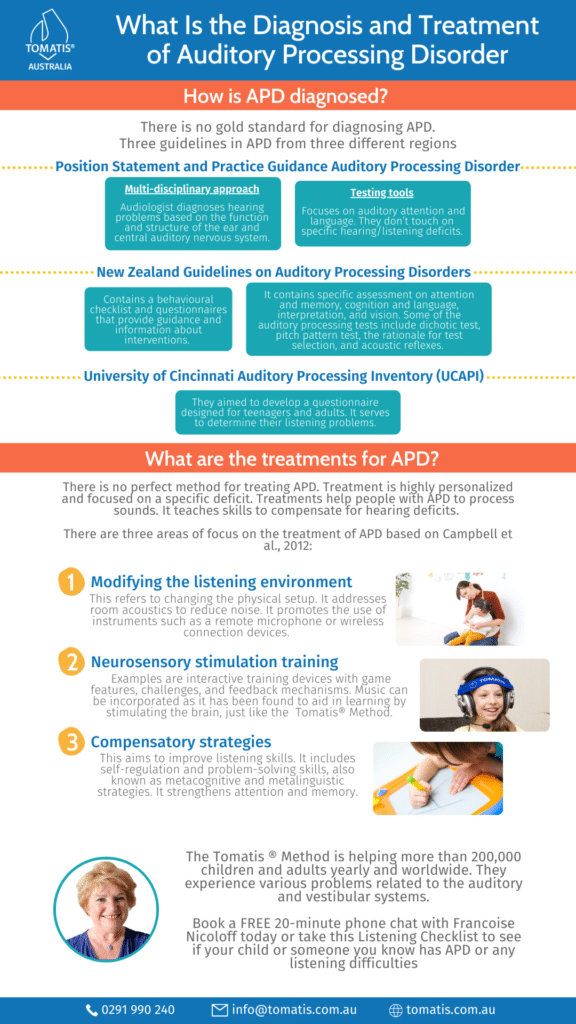Auditory Processing Disorder is one of the newest recorded auditory-related disorders in children ages 6-12 years old. The disorder is defined as the difficulty of children to understand what are the words being said or misinterpret the words being said. In this blog, we’ll be talking about the diagnosis and treatment for Auditory Processing Disorder in children and adults.
Luckily, we have the Tomatis® Method to give professional help to children suffering from Auditory Processing Disorder.
How is Auditory Processing Disorder (APD) diagnosed?
There is no gold standard for diagnosing auditory processing disorder in children or adults. More recent studies and various organisations suggested guidelines in APD. Three of these come from three different regions. These are the Position Statement and Practice Guidance Auditory Processing Disorder, New Zealand Guidelines on Auditory Processing Disorders, and the University of Cincinnati Auditory Processing Inventory.
- Position Statement and Practice Guidance Auditory Processing Disorder, 2018: The British Society of Audiology (BSA) came up with the Practice Guidance. It’s based on agreement and evidence-based practice on APD.
The Practice Guidance contains updated definitions and categories of APD. It presents a guide on APD assessment and management. The latest studies and future directions are also discussed.
The BSA pointed out the need to develop a universally accepted diagnostic test for APD. Some of the agreements noted about APD diagnosis are the following:
-
- Multi-disciplinary approach: Audiologist diagnoses hearing problems based on the function and structure of the ear and central auditory nervous system. But they lack sufficient knowledge on listening problems.
Listening problems may stem from cognitive processing besides hearing. Thus, audiologists with other medical professionals are needed to have a better assessment.
-
- Testing tools: There should be separate tests for adults and children. For example, adults may have acquired APD due to brain injury. The test used for the adult can’t be used for a child with developmental APD.
The existing APD tests focus on auditory attention and language. They don’t touch on specific hearing/listening deficits.
The BSA suggested a procedure for assessing APD. Practice Guidance thoroughly describes the steps on initial screening and review of case history. It presents the use of various tools such as pure-tone audiometry and immittance testing. It included battery tests on cognitive and language assessments. Finally, it emphasised the need to develop an integrated report and management plan.
2. New Zealand Guidelines on Auditory Processing Disorders, 2019: The Auditory Processing Disorder Reference Group prepared the Guidelines. It’s a comprehensive manual that contains the nature, assessment, tools, and management of APD.
The Guidelines wasn’t designed to diagnose APD. Instead, it contains a behavioural checklist and questionnaires that provide guidance and information about interventions. It offers evidence-based and age-appropriate tests for adults and children in New Zealand.
A checklist of symptoms and comorbidities helps medical professionals to identify people with APD. The recommended tools cover cognitive, language, and classroom performance. It contains specific assessment on attention and memory, cognition and language, interpretation, and vision. Some of the auditory processing tests include dichotic test, pitch pattern test, the rationale for test selection, and acoustic reflexes.
Other factors are considered, such as age, comorbidities, different types of hearing loss, and functional disability.
The NZ Guidelines presents management intervention principles, auditory training, and amplification methods. Additional references include parent and teacher guidance, audiobooks, and referral support services. Communication, phonology, language, and alternative therapies are part of the content.
3. University of Cincinnati Auditory Processing Inventory (UCAPI), 2019: The University of Cincinnati developed a standardised auditory processing inventory through a review. The researchers reviewed related literature on APD.
They found out that questionnaires used to assess listening problems aren’t appropriate for teenagers and adults. They aimed to develop a questionnaire designed for teenagers and adults. It serves to determine their listening problems.
The questionnaire was based on a 34-item questionnaire described by Del Zoppo et al. It comprised six areas of concern of people with APD. The researchers administered the questionnaire to 278 young adults. Three other studies were conducted to validate the data among participants with ADP and language-learning problems.
The UCAPI questionnaire provided an auditory profile as it covered the six listening concerns. It shows that people with previous APD diagnosis scored poorer than typical participants. The researchers concluded that it could be a valuable tool in diagnosing and developing strategies in the management of APD.

What is the hearing test forAuditory Processing Disorder (APD)?
Some children may have difficulty hearing even if they have no hearing loss. Audiologists can test for auditory processing disorder in children as well as in people of all ages. How old is your child? Most tests, though, are designed for children seven years and older.
An APD test may require your child to listen to a speech with a noisy background. Your child may be asked to identify any changes in sound and fill our gaps in words. These behavioural measures are called pure-tone audiometry, dichotic speech task, and temporal gap detection.
An audiologist uses appropriate equipment for electroacoustic and electrophysiologic measures. It includes the following tests as suggested in a study on APD among school-aged children:
- Auditory brainstem response
- Auditory middle latency response
- Immittance audiometry
- Otoacoustic emissions
Other medical professionals may be involved with your child’s diagnosis. Since APD is more than just a hearing problem, a psychologist assesses cognitive function. At the same time, a speech-language pathologist evaluates oral and written language.
What are the treatments for Auditory Processing Disorder (APD)?
There is no perfect method for treating auditory processing disorder in children or adults. Treatment is highly personalised and focused on a specific deficit. Effective treatment for auditory processing disorder in Sydney or other cities of Australia for one person doesn’t mean it applies to another person with APD. The proper remedy is based on accurate diagnosis and testing by a team of multidisciplinary medical professionals.
Treatment for auditory processing disorder in Sydney or other areas help people with APD to process sounds. It teaches skills to compensate for hearing deficits. It aids in restructuring the environment to manage APD. There are three areas of focus on the treatment of Auditory Processing Disorder based on Campbell et al., 2012:
- Modifying the listening environment: This refers to changing the physical setup. It addresses room acoustics to reduce noise. It promotes the use of instruments such as a remote microphone or wireless connection devices. Teachers are urged to practice proper communication, listening, and speaking skills during learning sessions.
- Neurosensory stimulation training: Examples are interactive training devices with game features, challenges, and feedback mechanisms. Music can be incorporated as it has been found to aid in learning by stimulating the brain.
A neurosensory stimulation training example is the Tomatis® Method. In the 1960s, Dr. Alfred Tomatis developed this solution to listening problems. He was a French doctor who specialised in ear, nose, and throat problems.
The Tomatis® Method uses a special device to play modified sounds or music. The modified sounds or music rewires the ear-brain connection. So finally, the brain can understand what the ears are hearing. It’s excellent for children and adults suffering from APD, learning difficulties, speech delay, autism, noise sensitivity, emotional dysregulation, sensory issues, as described before.
Compensatory strategies: This aims to improve listening skills. It includes self-regulation and problem-solving skills, also known as metacognitive and metalinguistic strategies. It strengthens attention and memory.

What is speech therapy for Auditory Processing Disorder (APD)?
A speech-language pathologist conducts the needed speech and language tests. The results of the tests serve as a basis in developing the appropriate auditory processing disorder therapy. Auditory processing disorder therapy is designed to improve listening skills in individuals.
Although, a study suggests more data is required to support the efficacy of speech-language for auditory processing disorder therapy. Speech-language pathologists are encouraged to perform comprehensive assessments and set goals that address language and literacy problems. Ultimately, the goal of auditory processing disorder therapy is to enhance auditory processing abilities.

Treating APD with The Tomatis® Method
Luckily, the Tomatis® Method can help your child cope with auditory processing difficulties. When you speak with our resident Tomatis® Method Francoise Nicoloff, you will get a clear walkthrough in just a FREE 20 min call. You can also take a listening check for assessment.
Françoise Nicoloff
Official Representative of Tomatis Developpement SA in Australia, Asia and South Pacific, Director of the Australian Tomatis® Method, Registered Psychologist, Certified Tomatis® Consultant Senior, Tomatis® International Trainer and Speaker, Co-author of the Listening Journey Series, 40 Years of Experience, Neurodiversity Speaker



